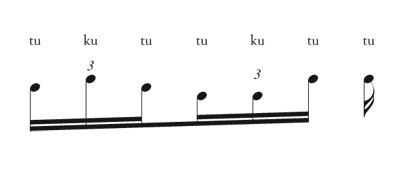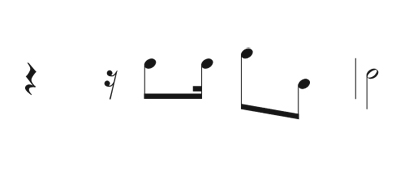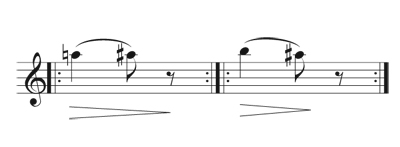
Composer Dan Welcher conducting Karl Kraber and former students in his Forest Devil Waltzes on themes of Emil Waldteufel (2015, World Premier) on May 16, 2015 at the First Unitarian Church, Austin, Texas. The concert celebrated Kraber’s 80th birthday.
Almost every professional flutist has played in a woodwind quintet at one time or another. Many orchestras have formed quintets, such as the Philadelphia and New York Philharmonic; universities have resident quintets comprised of the teacher/artist faculty; and several independent groups ranging from amateur to professional exist.
For a flutist, playing in a wind quintet such as the Dorian is both rewarding and challenging. Playing in any ensemble without a conductor helps you to become a better musician: you must participate more and be more responsible for the results.
The large repertoire for woodwind quintet includes many excellent 20th-century works. Many transcriptions, like the Bach organ works transcribed by Mordechai Rechtman, or those by Ross Taylor, are readily available.
Let us focus on one of France’s most sparkling composers, Jacques Ibert (1890-1962). He dedicated his flute compositions, the Concerto for flute and orchestra, and Pièce for solo flute to Marcel Moyse. Ibert wrote other enjoyable works: Deux Interludes for flute, violin, and harpsichord (or harp); and Deux Mouvements for two flutes, clarinet, and bassoon.
Ibert despaired that he would be known for only one piece, his popular orchestral tone poem Escales (Ports of Call). Now, 25 years after his death, his most performed work is Trois Pièces Brèves. Its tunefulness, charm, brilliance, and its clear neo-classical form make this short masterpiece enjoyable for all audiences from young to old, sophisticated to inexperienced. Every quintet needs to play this work, and every flutist should know it. The Dorian Quintet recorded this demanding piece and it is always a pleasure to perform. In an old Philadelphia Quintet recording, Kincaid’s beautiful and passionate playing, especially in the slow movement, provides a great example for flutists to emulate.
Movement I
Opening: Give a good preparation for a strong, accented downbeat. You are beating “two, play.” Remember, the “two” needs a little up down preparation itself. I pretend the flute is my baton, and between my hands (or my right thumb) is where the beat “clicks.”

The whole introduction should move forward and grow to rehearsal number 1. At rehearsal number 2, play very softly, yet with tiny accents. Practice the difficult low register attacks, approaching as in Marcel Moyse’s De la Sonorité. Remember to play softly, with clear attacks, making a diminuendo on each note. The figure:

should make a big contrast by being very legato with a huge but gradual diminuendo.
The happy main theme at rehearsal number 3 should be practiced carefully, but in many ways. First practice it evenly:

Then, in dotted rhythm:

Then, with reversed articulation, which helps check finger coordination:

Lastly, practice with triple tonguing for accurate rhythm:

The passage at rehearsal number 6 must be alive and move forward. Decrescendo, or come away on the eighths, and make a little crescendo on the sixteenths:

Be sure to tongue each beat, leaving no spaces between release and attack.
Movement II
The second piece is a lovely miniature, with the flute predominating almost all of the time. Make the most of an ample, broad, flowing, beautiful tone and good phrasing. Marked forte, it should never be forced. For a good legato, practice the whole movement with no spaces between the slurs:

Then practice the reverse:

Next practice the whole movement a half step lower:

This will help gain more control, to be more supple and relaxed in the lips. Then play it in Gb major, F major, etc. Also practice it fluttertongued, to relax the throat and lips.
At rehearsal number 1, I incorporate the breath’s from Kincaid’s recording, using his excellent phrasing for this passage. It is often more musical to break a slur than to breathe on the barline. In measures 13, 14, and the beginning of 15, play very softly with no vibrato so the clarinet can come through. After rehearsal number 2, play very smoothly with little vibrato; do not vibrate on the long Eb.
Movement III
Take a huge breath as if you are about to swim the entire length of the pool underwater, expanding from your belly. Give a very strong preparation and “pop” or “snap” attack to make sure the oboe and clarinet attack precisely and strongly with you. Continue to beat the third beat of m. 1 and the downbeat of m. 2. Be very still and listen to the horn’s rhythm:

Then give a small beat on the 2nd quarter note of m. 3 so you move off that note together with the oboe and clarinet. Give a gentle cut-off in m. 6. Looking to the right, I make a small counter-clockwise circle with the end of the flute, starting at the bottom at the 6 o’clock position, moving up through 3:00, over at 12:00, forward and then down at 3:00, and when I get back to 6:00, it is the exact moment of release.
At rehearsal number 1, give a good upbeat and downbeat for the bassoon, and play the staccato notes in the same manner as the first movement. A dramatic effect is to start mezzoforte and make a diminuendo over two bars. Again, keep these accompanying notes bouncy, using a light tongue coordinated with breath and make a diminuendo on each note.
At rehearsal number 3 practice this way:

and then:

At the fourth bar of rehearsal number 3 practice slowly at first without the grace notes, trying to get a strong clear attack, a big diminuendo, and a very good legato:

At three bars before rehearsal number 5, practice the skeleton:

Notice the second and third bars spell out an F# dominant seventh chord, bringing us to the key of B major for the clarinet solo at rehearsal number 5. Practice this several times in each of the following ways:

At rehearsal number 6, practice the skeleton like this:

Then practice it like this:

Two measures before rehearsal number 12, the F# dominant 7th harmony is not quite as obvious as the parallel measures before rehearsal number 5. Practice by adding the imaginary words, “I love you.”

Then practice it this way:

And finally:

Following these practice suggestions, create your own practice techniques which will help you play this piece or any other quintet literature more smoothly, musically, and expressively.






